Cat Skin disorders affect many cats whether they are indoors or outdoors. There are many different forms of cat skin disorders and most require a visit to the veterinarian to identify exactly which skin disorder is affecting your cat. There are a wide variety of immune-mediated skin disorders along with hereditary and developmental skin diseases and cutaneous manifestations of internal diseases) all of which can be caused by many different types of medical conditions in your cat.
Feline Acne
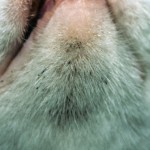 Feline Acne affects many cats. Although the exact cause of feline acne is unknown, many veterinarians suspect it may be caused by using plastic food dishes, stress, poor grooming habits and food allergies. Presenting itself as black spots on the chin and or the lips and often mistaken for dirt. Skin may become irritated with swollen red pustules that may bleed if irritated. The best treatment is to use metal, glass or ceramic food bowls and wash kitty’s face after each feeding.
Feline Acne affects many cats. Although the exact cause of feline acne is unknown, many veterinarians suspect it may be caused by using plastic food dishes, stress, poor grooming habits and food allergies. Presenting itself as black spots on the chin and or the lips and often mistaken for dirt. Skin may become irritated with swollen red pustules that may bleed if irritated. The best treatment is to use metal, glass or ceramic food bowls and wash kitty’s face after each feeding.
Bacterial Infections
Bacterial Infections may be caused by any of the infections below. Any infection should be checked by a veterinarian and treated as soon as possible in order to prevent further infection.
Yeast Infections
Yeast Infections are one of the most frustrating cat skin disorders to affect cats. Presented with red, inflamed, smelly skin, yeast infections can lead to hair loss, acne and dandruff. Yeast infections can affect ears, anal sacs, rectal areas as well as vaginal areas.
If a yeast infection is suspected take your cat to a veterinarian for a firm diagnosis. Usually treated with medications and shampoos your veterinarian will know exactly what to do. Wash all bedding frequently to remove all traces of yeast.
Ringworm
Ringworm, another of the common cat skin disorders, is a highly infectious skin disease caused by microscopic parasites. Ringworm is identified by round patches of hair loss usually on the head or legs. There may be grey patches with redness and itching as well as dry flaky skin.
If diagnosed with ringwork your cat will need to be treated as well as his environment. If there are other cats in the household all cats must be treated. A veterinarian will prescribe an anti fungal medication to be applied to the cats skin.
Sporotrichosis
Sporotrichosis, a fungus with the ability to infect skin, respiratory bones, and occasionally the brain, causes a distressed state in the cat. Skin will be irritated and look similar to other skin conditions described below. Originating out of doors, the fungus is found in dirt, plants and mosses. It can also be passed on zoonotically (from human to animal and back).
Always make sure to wash hands thoroughly after gardening to help prevent transference of this fungus. A visit to the veterinarian will examine skin and hair to see if the fungus is present. Hospitalize may be required for initial treatment and then the veterinarian may provide outpatient therapy for a few more weeks. Antifungal drugs are used to treat this condition.
Allergic Dermatitis
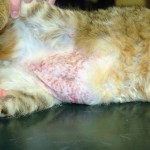 Allergic Dermatitis can present itself with many symptoms similar to other skin conditions. Itchy patches, thinning hair due to licking, acne, red bumps and a foul odor can all indicate allergic dermatitis. If the condition persists a visit to the veterinarian is in order.
Allergic Dermatitis can present itself with many symptoms similar to other skin conditions. Itchy patches, thinning hair due to licking, acne, red bumps and a foul odor can all indicate allergic dermatitis. If the condition persists a visit to the veterinarian is in order.
The veterinarian will examine the cat and perhaps take some skin and hair samples to look at under a microscope. The causes can be anything from a food reaction to a parasitic infestation. Once your veterinarian diagnoses the cause treatment can begin with either antibiotics or ointments or both. If it’s a food allergy, a diet change will also be in order.
Shedding and Hair Loss
Shedding and Hair Loss (Alopecia) is one of the cat skin disorders that may be difficult to diagnose. Usually causing patches of hair loss, the area of hair loss may indicate the underlying cause. Frequently accompanied with skin irriation and red scaly skin a veterinarian may have to take some skin samples and fur samples or test your cat for any allergies. Once your veterinarian knows the cause of the hair loss, he or she will be able to treat the condition accordingly.
Parasitic Diseases
Fleas and Lice
Fleas and Lice may cause a dermatitis (hypersensitivity to flea bites) on your cats skin. It is one of the most common cat skin disorders. Caused by a flea bite the cat may frequently scratch or bite himself through his fur.
Usually on the back or the base of the tail. There may also be raised scabs or bumps on the cats skin. Wash all bedding, eliminate fleas from kitty’s environment. Treat skin infections and if they become infected see a veterinarian for an antibiotic. There are many topical solutions, shampoos and antihistamines that a veterinarian may prescribe for your kitty to reduce symptoms.
Ear Mites
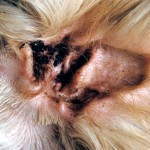 Ear Mites, another infectious skin disease, have cats shaking their heads. These parasitic creatures, no larger than a pin point, thrive in the ear canals on the moist environment.Frequently spreading to the skin, back, neck and tail, they multiply rapidly and are very contagious. Left untreated, they can cause bacterial and fungal infections.
Ear Mites, another infectious skin disease, have cats shaking their heads. These parasitic creatures, no larger than a pin point, thrive in the ear canals on the moist environment.Frequently spreading to the skin, back, neck and tail, they multiply rapidly and are very contagious. Left untreated, they can cause bacterial and fungal infections.
In rare cases they may cause a ruptured eardrum and hearing loss. This is one of the cat skin diseases most often found in kittens due to their lowered immune system. However, ear mites can affect cats of any age. A veterinarian will prescribe a liquid to be massaged in the ears daily for a week or so. A secondary visit to the veterinarian will be required to double check. As in fleas and lice, wash all bedding frequently.
Others
Stud Tail
Stud Tail will present with a waxy brown substance on the cats tail at the base. Treatments with special shampoos twice daily will usually prevent this condition. Corn starch and baby powder applied to the tail after shampooing will also help to alleviate the condition.
Eosinophilic Granuloma
Eosinophilic Granuloma are lesions that ooze, and may ulcerate, especially those on the bottoms of the cat’s feet. These may appear as swollen areas including the lips and skin. Treated with such things as prednisone, clavamox (an antibiotic), antihistimines and anti inflammatory medicatiosn this is an easily treated condition.
Skin Tumors
Skin Tumors, any lumps or bumps under the skin should be checked by a veterinarian. He will want to check these carefully and decide if surgery is required, if it’s simply fatty tissue or a neoplasm. There are many forms of treatment available including surgery, chemotherapy, and laser therapy.
Dry, Flaky Skin
Dry, Flaky Skin can be caused by environment, food allergies and other factors. Start with a Bath and a shampoo treatment. Also, a simple diet change maybe effective (more “fluids”), if this persist check with your veterinarian for additional treatment options.
In our next article we take a look at Cat Dander Allergies and the impacts it can have on your and your pet.
Thanks for visiting the Cat dandruff Clinic, if you liked this article please like us using the side bar .

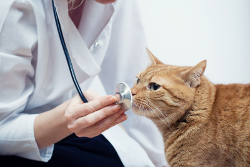

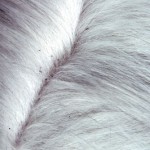
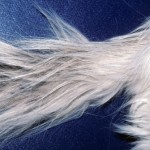
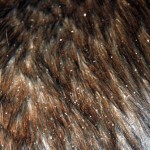
[…] [caption id="attachment_153" align="alignnone" width="219" caption="atopic dermatitis"][/caption][caption id="attachment_156" align="alignleft" width="275" caption="seborrheic dermatitis"][/caption…hind Atopic […]
[…] Helps relieve Mange & other parasitic infections […]
[…] your feline friend. Sometimes the flea bites can cause such extreme itching that it even leads to hair loss and infections of the skin.The best way to help your cat avoid exposure to fleas is to use preventative medicine. […]
[…] just a single flea bite can expose your cat to Flea Allergic Dermatitis (FAD). This disease is characterized by pain and itching. Normally since fleas thrive in warm […]
[…] Helps relieve Mange & other parasitic infections […]